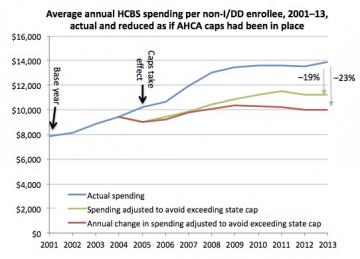The Potential Impact of the American Health Care Act on Home and Community-Based Services Spending
AN UPDATED VERSION OF THIS REPORT, BASED ON THE SENATE'S DRAFT BETTER CARE RECONCILIATION ACT, IS NOW AVAILABLE.
The American Health Care Act (AHCA) proposes to cap Federal Medicaid reimbursements to the states on a per-enrollee basis, effectively limiting growth to a rate only modestly exceeding the rate of inflation in healthcare costs. If the AHCA were to be enacted, it is reasonable to assume that most states would limit home and community-based services (HCBS) spending to the per-enrollee cap amount; otherwise, any excess comes entirely out of the state budget. This report uses state-by-state HCBS expenditures from 2001 through 2013 and compares the growth in spending during those years to the limitations that would have been in place had AHCA-like caps been imposed during those years. Findings indicate that caps would likely have caused the vast majority of states to limit HCBS growth, reducing increases in per-enrollee spending to substantially below the increases that actually occurred. By 2013, HCBS spending for people with physical disabilities, seniors, and other non-developmental disabilities would probably have been reduced by between 19% and 28% below actual spending. For programs targeted to people with intellectual or developmental disabilities, reductions of up to 13% would have occurred.
Last modified Jul 3, 2017

